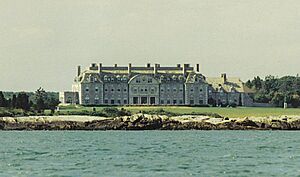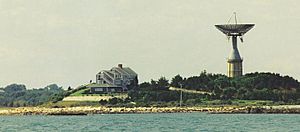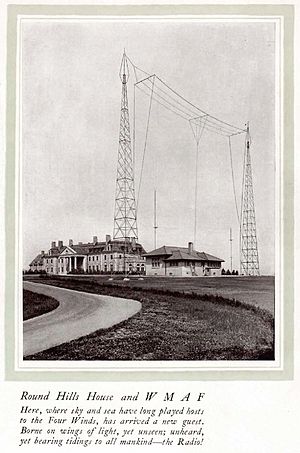Round Hill (Dartmouth, Massachusetts) facts for kids
Round Hill, originally known as Hap's Hill, is a special place in Dartmouth, Massachusetts. It has a long and interesting history and is now a private community.
Contents
History of Round Hill
Early Days and "Hap's Hill"

The first time anyone wrote about this hill was in 1602. A man named Gabriel Archer was on an expedition with Captain Bartholomew Gosnold. They sailed from England to what is now the New England area.
On May 25, 1602, their ship, the Concord, sailed into Buzzards Bay. They decided to set up a small settlement on an island nearby, which is now called Cuttyhunk Island. From there, Archer saw a hill on the mainland. He called it "Hap's Hill." He hoped that "much hap" (meaning good luck or good things) would come from it.
A few days later, Captain Gosnold and his crew went ashore. They met local native people, including men, women, and children. These friendly people welcomed them and offered gifts like furs, tobacco, and ornaments. The explorers were amazed by the beautiful land, saying it was "the goodliest continent that ever we saw." Later, people realized that "Hap's Hill" was the same place we now call Round Hill.
Ned Green and MIT's Time

Edward Howland Robinson Green, often called "Colonel" Ned Green, was a very wealthy man. His mother, Hetty Green, was famous for being a very successful businesswoman. After she passed away in 1916, Ned Green inherited a huge fortune.
He decided to build his home on Round Hill. The mansion was designed by architect Alfred C. Bossom and finished in 1921. It cost a lot of money, about $1.5 million back then!
In 1948, after Colonel Green had passed away, his sister Sylvia Green gave the entire property to the Massachusetts Institute of Technology (MIT). MIT is a famous university known for science and technology. They used the 240-acre estate for teaching and research until 1964.
MIT even built a giant antenna on top of a large water tank there. Another antenna was built nearby to help research a system for detecting missiles. This huge antenna became a well-known landmark for people on land and boats. The current owners of the site took it down in 2007.
After MIT, the property was sold to a religious group, the Society of Jesus, in 1964. They turned the mansion into a quiet place for retreats. Later, parts of the property, including the beach, were sold to the town of Dartmouth. In 1981, most of the land was sold to private developers. They turned it into the private, gated community it is today.
Radio Research at Round Hill
Colonel Green was very interested in radio technology, even in the 1890s. In 1922, he started the Round Hills Radio Corporation. They built a special building next to his mansion for radio broadcasts and experiments.
In September 1922, they got licenses for a radio station called WMAF. They also had an experimental station, 1XV. WMAF only broadcast during the summer months from 1923 to 1928. It was known as The Voice from Way Down East.
MIT's President, Samuel W. Stratton, and their Electrical Engineering department were invited to use the new radio technology. Colonel Green even helped fund their early work. Scientists like Professor Edward L. Bowles studied how radio signals traveled.
The radio station at Round Hill was very important. It had an early radio telescope built on a water tower that looked like a lighthouse. This station helped track polar expeditions, like those of Donald B. MacMillan and Admiral Richard E. Byrd. It also followed the Graf Zeppelin airship on its first trip across the Atlantic Ocean. When Vermont had terrible floods in 1927, Round Hill's radio station was the only way for people in the flooded areas to communicate.
Van de Graaff's Electrical Experiments
In 1933, Round Hill was home to amazing electrical experiments by Robert J. Van de Graaff. He was a scientist who came to MIT to build a powerful high-voltage research facility.
He built a giant Van de Graaff generator inside an old airship hangar at Round Hill. This machine was 40 feet tall! Its purpose was to create enough energy to speed up tiny particles. These particles could then be used to study the center of atoms. The machine started working in December 1933 and could create 5 million volts of electricity.
Later, when the generator was no longer needed for research, it was given to the Museum of Science, Boston in 1956. You can still see it working there today as a major exhibit!
The Whaling Ship Charles W. Morgan
The famous New Bedford whaling ship Charles W. Morgan was once partly owned by Colonel Green. This historic ship, which is now on display at Mystic Seaport, was even docked at Round Hill for a time.
World War II Role
During World War II, the Coast Artillery built a special structure at Round Hill. This building was used to help control gunfire from coastal defenses. The site was known as the Mishaum Point Military Reservation.
Recent Changes
In 2007, the Round Hill property was sold again. The town's Historical Commission tried to save the large antenna that MIT had built, but they were not successful. On November 19, 2007, the new owner took down the antenna. It had stood there for 90 years and was a well-known landmark for boats and people in the area. The new owner planned to build a new home on the site.


